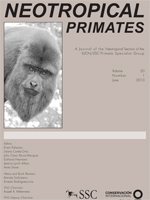In their description of the Prince Bernhard's titi monkey, Callicebus bernhardi, van Roosmalen et al. (2002) suggested that it might occur on the west bank of the Rio Ji-Paraná in the state of Rondônia, Brazil, based on the observation of an undetermined greyish titi monkey at the Pimenta Bueno Municipal Park in Pimenta Bueno by Ferrari et al. (1996; later identified as C. moloch by Ferrari et al., 2000). The presence of C. bernhardi in this region was confirmed by Monção et al. (2008) in Alto Alegre dos Parecis. Here we report its occurrence in forest fragments to the west of the Rio Ji-Paraná in Rolim de Moura.
Figure 1.
Adult Prince Bernhard's titi monkey carrying the newborn (see the tip of its tail above the adult's left leg). Photograph by E. P. Quintino.

Social groups of Prince Bernhard's titi monkeys were sighted in the following forest fragments from January to October 2013:
- Sítio Nossa Senhora Aparecida (11°47′59.87″S, 61°47′03.19″W; ca. 2.3 ha) - group composed of four individuals (an adult male, an adult female, a juvenile, and an infant born in August 2013; Fig. 1). These titi monkeys were observed ad libitum (Altmann, 1974) feeding on fruit of Oenocarpus distichus and Orbignya phalerata (Arecaceae) and fruit and young leaves of Inga sp. (Fabaceae) and unidentified shrubs and lianas;
- Sítio São José (11°48′38.54″S, 61°46′31.85″W; ca. 2.5 ha) - group composed of, at least, five individuals;
- Sítio Nova Boa Esperança (11°48′07.52″S, 61°47′00.98″W; ca. 2 ha) - group composed of, at least, two individuals.
Acknowledgements
We thank the owners of the study sites, Salete Bergamin Quintino, Osvaldo Pivolio and Reinaldo Prudente Ribeiro, for the permission to visit their ranches. Mrs. Salete B. Quintino also provided logistical and financial support for this study. EPQ is supported by a Graduate (M.Sc.) fellowship from the Brazilian Higher Education Authority/CAPES and JCBM is supported by a research fellowship from the Brazilian National Research Council/CNPq (PQ ID #303154/2009-8). This study was approved by the Scientific Committee of the Faculdade de Biociências/Pontifícia Universidade Católica do Rio Grande do Sul (#033/11).





